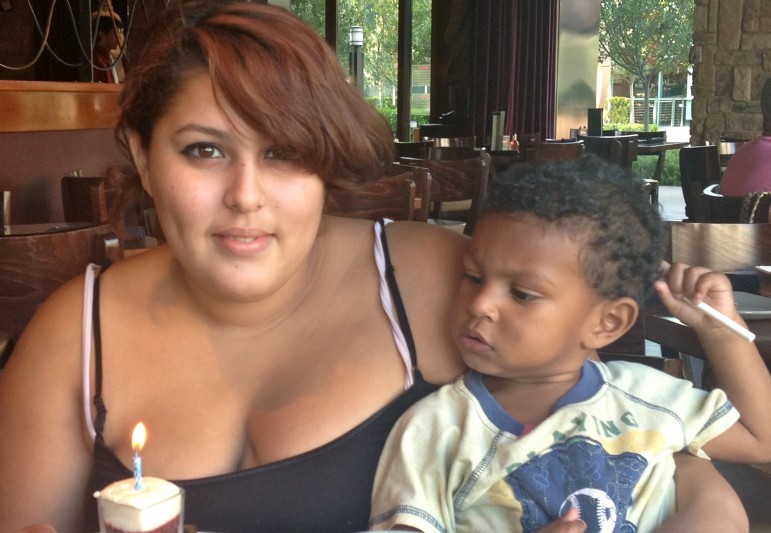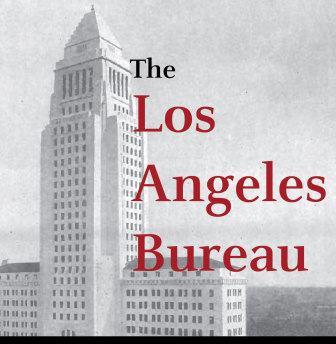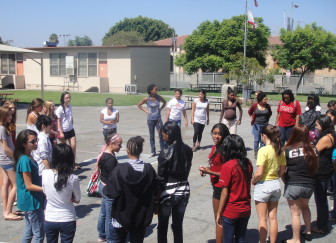
Raquelle Miranda and her son, Issac, on his third birthday.
LOS ANGELES — Beginning when she was 13, Raquelle Miranda had several encounters with the juvenile justice system. She had her first child, Issac, when she was 17. She never had the chance to attend her high school prom, or take part in many of the other activities that most teenagers consider to be rites of passage.
Nevertheless, Miranda graduated in May 2012 from Thomas Riley High School in Watts.
 Thomas Riley is an alternative continuous enrollment school within the Los Angeles Unified School District (LAUSD) dedicated solely to educating pregnant and parenting teenage women. Inside, the school looks very different from most high schools. The classroom walls are covered in anatomical charts illustrating the stages of pregnancy as well as images of the female reproductive system. In one corner of a classroom, the floor is covered with toys to keep babies occupied and happy.
Thomas Riley is an alternative continuous enrollment school within the Los Angeles Unified School District (LAUSD) dedicated solely to educating pregnant and parenting teenage women. Inside, the school looks very different from most high schools. The classroom walls are covered in anatomical charts illustrating the stages of pregnancy as well as images of the female reproductive system. In one corner of a classroom, the floor is covered with toys to keep babies occupied and happy.
Although it’s uncommon for so many pregnant teenage women to be in one classroom, the students at Thomas Riley feel many of the same pressures and deal with many of the same challenges as students at traditional high schools.
However, there is one key difference: each day when the bell rings and the young women head home for the day, they don’t just have themselves to take care of, but their children as well.

Thomas Riley High School is dedicated solely to educating pregnant and parenting teenage women.
Many students choose to attend Thomas Riley as an alternative to a traditional high school. Some other students, like Miranda, were forced to leave their former high schools after they became pregnant.
“I used to go to Lynwood High School, but I was told that I wouldn’t be able to keep going there after I hit the eight month mark in my pregnancy,” Miranda says. “Then my mom found out about Thomas Riley and I checked into the school soon after.”
Serena Au, a practicing occupational therapist who is familiar with the school, says that the school's benefits include the flexible classroom structure and the special accommodations that are made for the pregnant and parenting students.
“The school definitely caters to the specialized needs of the students,” Au says. “First, the school offers unique physical education and childbirth classes for the girls. Also, Riley offers a credit-based learning system where the students work at their own pace and just need to earn a certain number of credits to complete a class. This makes the classes more manageable in case the girls have to miss school for reasons relating to their pregnancy or the health of their babies.”
Additionally, the teachers at Thomas Riley tend to give fewer homework assignments in order to allow the girls to focus on their children while they are at home.
“One of the nice things about Thomas Riley is that the teachers give you the chance to get almost all of your work done in class so you don’t have to do it at home,” Miranda explains. “They understand that we have our kids to take care of, so they try to not to give us a lot of work to do outside of school.”
The ultimate goal of these accommodations is rather simple: encourage educational success for teen mothers and their kids.
Since 1994, LAUSD has offered the Teen Parent Program to support and assist pregnant and parenting students within the school district.
The program works closely with Thomas Riley and McAlister High School, another LAUSD school for pregnant and parenting teens.
According to the program’s website, “Pregnancy has been determined to be the greatest single cause of dropping out for female students.”
In addition, the website explains, “Both research and experience demonstrate that by protecting their educational rights, providing high quality educational options, and assuring access to support services such as child care and case management, schools can help to ensure the educational and future success of both teen parents and their children.”
However, Au says that ensuring educational success for the students at Thomas Riley is not easy.
“On top of the difficulties associated with being a teen mom, a lot of the students at Thomas Riley have unstable home environments and are lacking in financial resources,” Au says. “A lot of the girls have grown up in some of the most impoverished neighborhoods in L.A. where crime is high and resources are low.”
Although the overall crime rate in Watts has actually decreased in recent years, the community surrounding Thomas Riley still experiences a relatively high number of violent crimes and property crimes annually.
According to data published this year in the Los Angeles Times’ “Mapping L.A.” crime report, Watts has the eleventh highest violent crime rate out of the 209 neighborhoods that were surveyed.
“A lot of the girls at Riley have gone through tough times. Many of the girls have friends or family members who are or have been in jail and some of the girls have even gotten in legal trouble themselves,” Au says. “If the girls start getting in trouble with the law, or even just in school, at a young age, it can be a slippery slope. By emphasizing the importance of secondary education and encouraging them to explore various career options, the teachers and volunteers at the school hope to keep the girls on a positive path that will promote future success. ”
Many graduates of Thomas Riley High School credit the supportive teachers and the specialized nature of the school for their educational success. Each year, an increasing number of students graduate from Thomas Riley and go on to attend a college or university.
For Miranda, Thomas Riley is hopefully only the beginning of her education.
Although she is currently taking time off to raise her son Issac, she has been accepted into several four-year colleges in Los Angeles and hopes to go back to school in the future. Currently, she is possibly interested in pursuing a career as either a teacher or a nurse.
“Thomas Riley was a great choice for me,” Miranda says. “It was nice having classmates who were all going through the same things and teachers that wanted to help us. Believe me, it’s definitely not easy trying to be a student, mom, and a teenager all at the same time.”
Financial supporters of The JJIE may be quoted or mentioned in our stories. They may also be the subjects of our stories.
